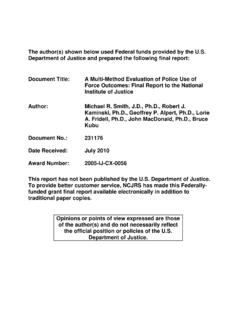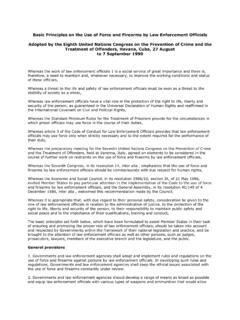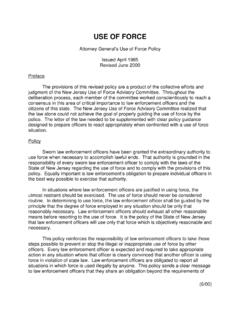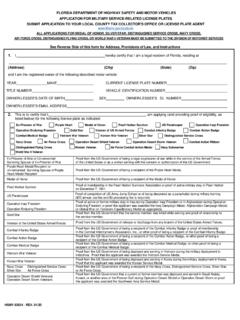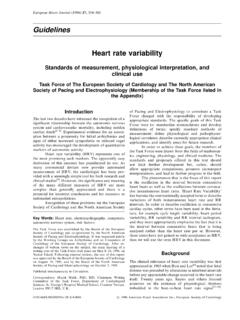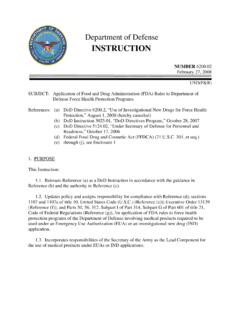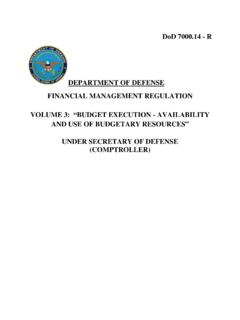Transcription of Training Operational Environment and Opposing Force Program
1 Army Regulation 350 2 TrainingOperationalEnvironmentand OpposingForce ProgramHeadquartersDepartment of the ArmyWashington, DC19 May 2015 UNCLASSIFIEDSUMMARY of CHANGEAR 350 2 Operational Environment and Opposing Force ProgramThis major revision, dated 19 May 2015----o Changes the title of the regulation from Opposing Force (OPFOR) Program toOperational Environment and Opposing Force Program (cover).o Replaces the term contemporary Operational Environment with operationalenvironment (para 1-5a).o Describes the composition of a hybrid threat-based Opposing Force (para 1-5b).o Describes Operational Environment fidelity levels (para 1-6).o Updates responsibilities to support the Operational Environment and OpposingForce Program (chap 2).o Replaces intelligence support with tailored Operational Environment trainingsupport (paras 2-8, 3-2).o Identifies, informs, and supports doctrine, organization, Training ,materiel, leadership, personnel, facilities, and policy evaluation ofoperational Environment and Opposing Force Training capability gaps (para 2-8).
2 O Directs Army Cyber Command to assist the Army Training and DoctrineCommand Deputy Chief of Staff, G2 in defining cyber threats that need to beintegrated as an Opposing Force capability for collective Training venues(para 2-12).o Replaces Combat Training Center specific roles in major, regional, and smallscale contingency operations with Army core competencies of combined armsmaneuver and wide area security operations (para 3-3).o Changes Opposing Force doctrinal and organizational guidelines tooperational and organizational guidelines (para 3-3).o Provides Opposing Force Operational and organizational guidelines for Army Reserve (para 3-3c(6)).o Adds leader development programs and Training seminars, as appropriate, tothe Operational Environment and Opposing Force accreditation Program (para 3-6).HeadquartersDepartment of the ArmyWashington, DC19 May 2015 TrainingOperational Environment and Opposing Force Program *Army Regulation 350 2 Effective 19 June 2015H i s t o r y.
3 T h i s p u b l i c a t i o n i s a m a j o This regulation prescribes re-sponsibilities, concepts, and policies con-c e r n i n g i n t e g r a t i o n o f t r a i n i n genvironment complexities and the Opera-tional Environment and Opposing ForceProgram into Army Operational and in-stitutional This regulation applies tot h e A c t i v e A r m y , t h e A r m y N a t i o n a lGuard/Army National Guard of the UnitedStates, and the Army Reserve, unlessotherwise stated. It supports Departmentof Defense Joint Service Operational envi-ronment and Opposing Force programs forleader development, Training , and educa-tion. This regulation will not be modifiedduring and exception proponent of this regulation is theDeputy Chief of Staff, G 2. The propo-nent has the authority to approve excep-tions or waivers to this regulation that areconsistent with controlling law and regu-lations.
4 The proponent may delegate thisapproval authority, in writing, to a divi-sion chief within the proponent agency orits direct reporting unit or field operatingagency, in the grade of colonel or thecivilian equivalent. Activities may requesta waiver to this regulation by providingjustification that includes a full analysis oft h e e x p e c t e d b e n e f i t s a n d m u s t i n c l u d ef o r m a l r e v i e w b y t h e a c t i v i t y s s e n i o rlegal officer. All waiver requests will bee n d o r s e d b y t h e c o m m a n d e r o r s e n i o rleader of the requesting activity and for-warded through their higher headquarterst o t h e p o l i c y p r o p o n e n t . R e f e r t o A R25 30 for specific internal control process. Thisregulation contains internal control provi-sions in accordance with AR 11 2 andidentifies key internal controls that mustbe evaluated (see appendix C).
5 S u p p l e m e n t a t i o n . S u p p l e m e n t a t i o n o fthis regulation and establishment of com-mand and local forms are prohibited with-out prior approval from the Deputy Chiefo f S t a f f , G 2 ( D A M I F I ) , 1 0 0 0 A r m yPentagon, Washington, DC 20310 improvements. Users arei n v i t e d t o s e n d c o m m e n t s o r s u g g e s t e dimprovements on DA Form 2028 (Recom-m e n d e d C h a n g e s t o P u b l i c a t i o n s a n dBlank Forms) to the Office of the DeputyC h i e f o f S t a f f , G 2 ( D A M I F I ) , 1 0 0 0A r m y P e n t a g o n , W a s h i n g t o n , D C20310 management. AR 15 1 re-quires the proponent to justify establish-i n g / c o n t i n u i n g c o m m i t t e e ( s ) , c o o r d i n a t edraft publications, and coordinate changesin committee status with the Office of theAdministrative Assistant to the Secretaryof the Army, Department of the ArmyCommittee Management Office (AARP-ZA), 9301 Chapek Road, Building 1458,Fort Belvoir, VA 22060 5527.
6 Further, ifi t i s d e t e r m i n e d t h a t a n e s t a b l i s h e d group identified within this regulation,later takes on the characteristics of a com-mittee, as found in the AR 15 1, then theproponent will follow all AR 15 1 re-quirements for establishing and continuingthe group as a This publication is availa-ble in electronic media only and is in-tended for command levels C, D, and Efor the Active Army, the Army NationalGuard/Army National Guard of the UnitedStates, and the Army (Listed by paragraph and page number)Chapter 1 Introduction, page 1 Purpose 1 1, page 1 References 1 2, page 1 Explanation of abbreviations and terms 1 3, page 1 Responsibilities 1 4, page 1 Operational Environment and Opposing Force Program 1 5, page 1*This regulation supersedes AR 350 2, dated 9 April 350 2 19 May 2015iUNCLASSIFIEDC ontents ContinuedThree Training and leader development Operational Environment fidelity levels 1 6, page 2 Chapter 2 Responsibilities, page 2 Assistant Secretary of the Army (Acquisition, Logistics and Technology)
7 2 1, page 2 The Chief, National Guard Bureau 2 2, page 2 Deputy Chief of Staff, G 1 2 3, page 3 Deputy Chief of Staff, G 2 2 4, page 3 Deputy Chief of Staff, G 3/5/7 2 5, page 3 Deputy Chief of Staff, G 4 2 6, page 3 Chief, Army Reserve 2 7, page 4 Commanding General, Army Training and Doctrine Command 2 8, page 4 Commanding General, Army Materiel Command 2 9, page 5 Commanding General, Army Forces Command 2 10, page 5 Commanding General, Army Europe 2 11, page 5 Commanding General, Army Cyber Command 2 12, page 5 Commanding General, Army Test and Evaluation Command 2 13, page 5 Chapter 3 Planning and Management, page 6 Program policies 3 1, page 6 Operational Environment representation guidelines 3 2, page 6 Opposing Force Operational and organizational guidelines 3 3, page 7 Program management 3 4, page 7 Sustainment 3 5, page 8 Operational Environment and Opposing Force accreditation and/or validation 3 6, page 9 Training restrictions 3 7, page 10 Public affairs coordinating instructions 3 8, page , page of Opposing Forces in Scenarios, page Control Evaluation, page 14 GlossaryiiAR 350 2 19 May 2015 Chapter 1 Introduction1 1.
8 PurposeThis regulation sets responsibilities, concepts, policies, and procedures for the Department of the Army (DA) Opera-tional Environment (OE) and Opposing Force (OPFOR) Program . It covers all Army OE and OPFOR activities in live,virtual, constructive, and gaming environments across the Operational and institutional domains in support of leaderdevelopment, Training , education, and other developmental functions. This regulation clarifies responsibilities basedupon current intelligence and Training policies and 2. ReferencesRequired and related publications and prescribed and referenced forms are listed in appendix 3. Explanation of abbreviations and termsAbbreviations and special terms used in this regulation are explained in the 4. ResponsibilitiesResponsibilities are listed in chapter 5. Operational Environment and Opposing Force Programa.
9 Operational Environment . An OE is a composite of the conditions, circumstances, and influences that affect theemployment of capabilities and bear on the decisions of the commander (Joint Publication (JP) 3 0). Army DoctrinePublication (ADP) 3 0 and Army Doctrine Reference Publication (ADRP) 3 0 describe the OE in terms of eighto p e r a t i o n a l v a r i a b l e s : p o l i t i c a l , m i l i t a r y , e c o n o m i c , s o c i a l , i n f o r m a t i o n , i n f r a s t r u c t u r e , p h y s i c a l t e r r a i n , a n d t i m e(PMESII PT); Army forces use these Operational variables to understand and analyze the broad Environment in whichthey are conducting operations. ADP 7 0 established the understanding of the OE as one of the 11 Army principlesof unit Training ; integrating the conditions of the expected OE into the Training Environment provides commanders thefull range of experiences needed to produce trained units and capable leaders.
10 The strategic security environmentcontains multiple potential OEs, which are defined as any areas in which forces may operate, from a locale assmall as a village to entire regions of the globe. Because we cannot always predict where forces will have to deploy, Training environments must account for multiple (composite) likely OEs. Conditions should represent those expectedOEs as much as possible. A Training Environment can be a representation of any one expected OE or a composite ofmultiple OEs. For simplicity, the use of OE and Training Environment are interchangeable in this regulation. Whileother non-dedicated OPFOR may be created for use in Training events, all OPFOR will operate using doctrine andorganizational structures approved by the Army Training and Doctrine Command (TRADOC), Deputy Chief ofStaff (DCS) for Intelligence, Opposing forces.










